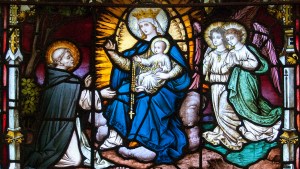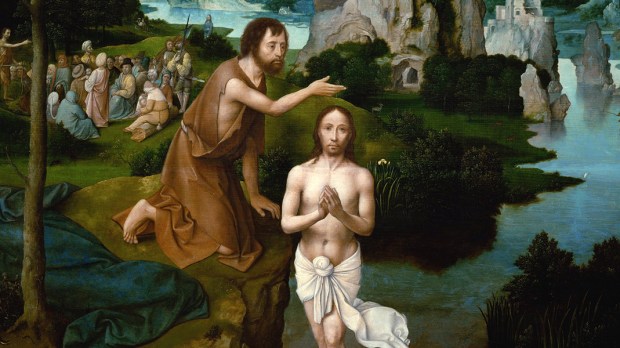I received several appreciative comments about the Joseph Rosary, which contemplated St. Joseph’s relationship with Jesus in the Joyful Mysteries of the Rosary. Here is a way to pray the Rosary that highlights the doctrines that the Luminous Mysteries point to.
St. Pope John Paul II, St. Pope Paul VI, and St. Louis Marie de Montfort all recommend drawing attention to Jesus while praying the Hail Marys of a Rosary by adding words or phrases after Jesus’ name in the first half of each Hail Mary. For instance:
Annunciation: “… and blessed is the fruit of thy womb Jesus, conceived in you by the Holy Spirit. Holy Mary, Mother of God …”
Agony in the Garden: “… and blessed is the fruit of thy womb Jesus, in agony for our sins. Holy Mary, Mother of God …”
I included a guide to each mystery in my book The Rosary of Saint John Paul II. We Hoopeses have expanded on this, in order to use our daily Rosary to remind us of the truths of the faith. Here is a way to pray the Luminous Mysteries focused on specific doctrines.
First Luminous Mystery: The Baptism of Jesus
Jesus submits to be baptized by John as an example to us to follow in baptism.
Hail Mary, full of grace, the Lord is with thee! Blessed art thou among women, and blessed is the fruit of thy womb Jesus,
… who in our baptism incorporates us into Christ and his Church.
… who in our baptism bestows on us the gifts of the Holy Spirit.
… who in our baptism gives us communion with all Christians.
… to whom we make six baptismal promises.
… to whom we promise to reject sin in order to live in the freedom of God’s children.
… to whom we promise to reject the glamour of evil, and refuse to be mastered by sin.
… to whom we promise to reject Satan, father of sin and prince of darkness.
… in whom we profess God, the Father Almighty, creator of heaven and earth.
… who we profess to be God the Father’s only Son, our Lord.
… in whom we profess the Holy Spirit and the holy Catholic Church.
Second Luminous Mystery: The Wedding Feast at Cana
Jesus manifests his glory with his first miracle, but also sanctifies marriage with his presence.
Hail Mary, full of grace, the Lord is with thee! Blessed art thou among women, and blessed is the fruit of thy womb Jesus,
… who is the bond of the sacrament of marriage.
… whose union with the Church is signified by marriage.
… who makes marriage “a domestic Church” teaching virtue and faith.
… in whom married couples vow exclusive love “without coercion, freely and wholeheartedly.”
… in whom married couples vow “to love and honor each other for as long as you both shall live.”
… in whom married couples vow “to accept children lovingly from God.”
… in whom married couples vow “to bring [children] up according to the law of Christ and his Church.”
… in whom married couples promise fidelity “in good times and in bad.”
… in whom married couples promise fidelity “in sickness and in health.”
… in whom married couples promise fidelity “for richer and poorer.”
Third Luminous Mystery: The Proclamation of the Kingdom
Jesus proclaims the Kingdom of God in his teaching ministry.
Hail Mary, full of grace, the Lord is with thee! Blessed art thou among women, and blessed is the fruit of thy womb Jesus,
… who said “Blessed are the poor in spirit, for theirs is the kingdom of heaven.”
… who said “Blessed are they who mourn, for they will be comforted.”
… who said “Blessed are the meek, for they will inherit the earth.”
… who said “Blessed are they who hunger and thirst for righteousness, for they will be satisfied.”
… who said “Blessed are the merciful, for they will be shown mercy.”
… who said “Blessed are the pure of heart, for they will see God.”
… who said “Blessed are the peacemakers, for they will be called children of God.”
… who said “Blessed are those who are persecuted for righteousness’ sake, for theirs is the kingdom of heaven.”
… who said “Whoever breaks one of the least of [the] commandments and teaches others to do so will be called least in the kingdom of heaven.”
… who said “But whoever obeys and teaches [the] commandments will be called greatest in the kingdom of heaven.”
Fourth Luminous Mystery: The Transfiguration
Jesus, transfigured on Mont Tabor, is joined by Moses and Elijah, who both heard God on the mountain of the Ten Commandments, Mount Sinai.
Hail Mary, full of grace, the Lord is with thee! Blessed art thou among women, and blessed is the fruit of thy womb Jesus,
… in whom we follow the first commandment: “I am the LORD your God: you shall not have strange Gods before me.”
… in whom we follow the second commandment: “You shall not take the name of the LORD your God in vain.”
… in whom we follow the third commandment: “Remember to keep holy the LORD’S day.”
… in whom we follow the fourth commandment: “Honor your father and your mother.”
… in whom we follow the fifth commandment: “You shall not kill.”
… in whom we follow the sixth commandment: “You shall not commit adultery.
… in whom we follow the seventh commandment: “You shall not steal.”
… in whom we follow the eighth commandment: “You shall not bear false witness against your neighbor.”
… in whom we follow the ninth commandment: “You shall not covet your neighbor’s wife.”
… in whom we follow the tenth commandment: “You shall not covet your neighbor’s goods.”
The Fifth Luminous Mystery: The Institution of the Eucharist
Jesus Institutes the Holy Eucharist. The Catechism lists several fruits of Holy Communion.
Hail Mary, full of grace, the Lord is with thee! Blessed art thou among women, and blessed is the fruit of thy womb Jesus,
… in the Eucharist, the first fruit of which is “an intimate union with Christ Jesus” (CCC 1391).
… in the Eucharist, which achieves in our spiritual life “what material food produces in our bodily life” (CCC 1392).
… in the Eucharist, whose “Holy Communion separates us from sin” (CCC 1393).
… in the Eucharist, which “strengthens charity” (CCC 1394).
… in the Eucharist, which “wipes away venial sins” (CCC 1394).
… in the Eucharist, which “preserves us from future mortal sins” (CCC 1395).
… in the Eucharist, which “makes the Church” (CCC 1396).
… in the Eucharist, which “commits us to the poor” (CCC 1397).
… in the Eucharist, which “[works toward] the unity of Christians” (CCC 1398).
… in the Eucharist, our “pledge of the glory to come” (CCC 1402-1405).

Read more:
St. John Paul II wasn’t the first to propose Luminous Mysteries

